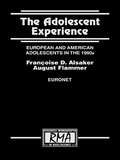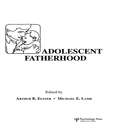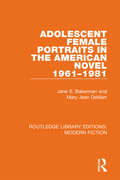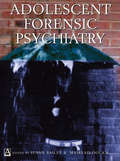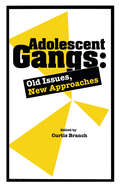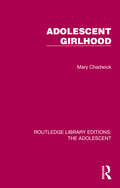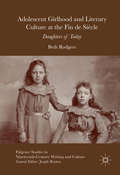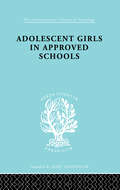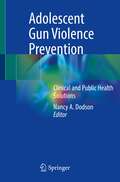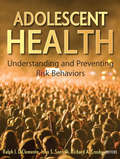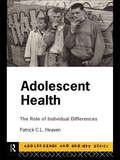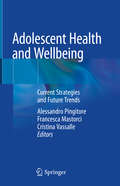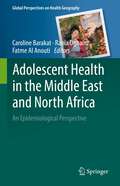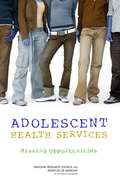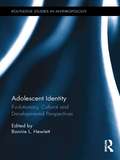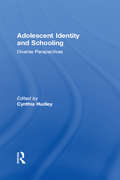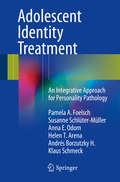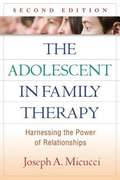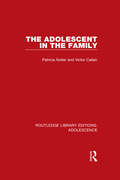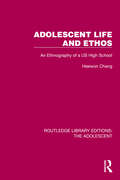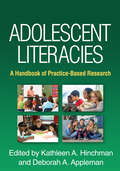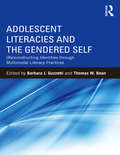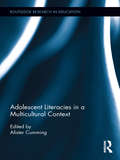- Table View
- List View
The Adolescent Experience: European and American Adolescents in the 1990s (Research Monographs in Adolescence Series)
by August Flammer Francoise D. AlsakerThe opening of the borders to Eastern Europe has expanded our view on European diversities and offered new opportunities to examine the effects of the heterogeneity in European cultural backgrounds and political systems on personality and social development. This book is a first step in utilizing the rich cultural resource offered by the large number of cultural units represented in Europe and--at least in part--in the United States. One way to understand the life conditions of adolescents in different countries is to study what they actually do in everyday life and how much time they spend on what types of activities. This book also provides essential and new information about individual and societal priorities and values. Toward this end, the "Euronet" scientists set up a postdoctoral training workshop on adolescent psychology for 10 selected American and 10 selected European participants. The Euronet project comprises 13 different samples--six stemming from Middle and Eastern European countries (Bulgaria, the Czechoslovakian Federal Republic, Hungary, Poland, Russia, and Romania), six from Western European countries (Finland, France, Germany, Norway, French, and German Switzerland), and one from the United States (Michigan). This book reports the results of this large, cross-national, longitudinal study of adolescents and the world(s) in which they live, and is offered to all those who have an interest in adolescence and/or the diversity of Europe. Readers will learn about hundreds of features of adolescence which are more or less characteristic of the cultures, ages, and genders.
Adolescent Fatherhood
by ARTHUR B. ELSTER and MICHAEL E. LAMBFirst published in 1986. Routledge is an imprint of Taylor & Francis, an informa company.
Adolescent Female Portraits in the American Novel 1961-1981 (Routledge Library Editions: Modern Fiction)
by Jane S. Bakerman Mary Jean DeMarrOriginally published in 1983, this title lists and annotates reference sources which will help readers select primary materials useful in studies of the literary portraits of women and their societal roles. The years 1961 to 1981 were set as boundaries for this volume because the author’s initial research revealed that a twenty-year span was a manageable unit, because the novels published between those dates yielded abundant materials for such a reference work, and because significant changes in the way portraits of adolescent females were being drawn took place during the period – for example, sex-role stereotyping became a shade less prevalent, young women’s sexuality was discussed more forthrightly, and some topics (such as single women’s pregnancies and lesbianism) were treated more overtly, sometimes less judgementally.
Adolescent Forensic Psychiatry
by Susan Bailey Mairead DolanAdolescent Forensic Psychiatry discusses a broad range of issues based around the psychiatric needs of adolescents and how these relate to offending behaviour. Its well-structured approach looks at assessment, treatment and outcomes for different disorders and highlights the importance of effective interaction between specialist agencies. Services
Adolescent Gangs: Old Issues, New Approaches
by Curtis W. BranchPublished in 1998, Adolescent Gangs is a valuable contribution to the field of Counseling and School Therapy.
Adolescent Girlhood (Routledge Library Editions: The Adolescent)
by Mary ChadwickOriginally published in 1932, Adolescent Girlhood set out to give a general view of the more everyday problems a girl might encounter during adolescence. Both at home and at school and those problems that had, despite their prevalence, not gained as much attention or understanding as they merited or required. It was assumed that readers interested in development would have had some knowledge of the general concepts of psychology and psychoanalysis, given the prominence of discoveries in these fields over the previous ten to twenty years. <p><p> It starts with some history of the adolescent girl, including their representation in literature and goes on to cover issues such as physical changes, as well as psychological and emotional expectations. Today it can be read and enjoyed in its historical context. <p><p> This book is a reissue first published in 1932. The language used is a reflection of its era and no offence is meant by the Publishers to any reader by this re-publication.
Adolescent Girlhood and Literary Culture at the Fin de Siècle: Daughters of Today (Palgrave Studies in Nineteenth-Century Writing and Culture)
by Beth RodgersThis book examines the construction of adolescent girlhood across a range of genres in the closing decades of the nineteenth century. It argues that there was a preoccupation with defining, characterising and naming adolescent girlhood at the fin de si#65533;cle. These 'daughters of today', 'juvenile spinsters' and 'modern girls', as the press variously termed them, occupying a borderland between childhood and womanhood, were seen to be inextricably connected to late nineteenth-century modernity: they were the products of changes taking place in education and employment and of the challenge to traditional conceptions of femininity presented by the Woman Question. The author argues that the shifting nature of the modern adolescent girl made her a malleable cultural figure, and a meeting point for many of the prevalent debates associated with fin-de-si#65533;cle society. By juxtaposing diverse material, from children's books and girls' magazines to New Woman novels and psychological studies, the author contextualises adolescent girlhood as a distinct but complex cultural category at the end of the nineteenth century.
Adolescent Girls in Approved Schools (International Library of Sociology)
by Helen J. RichardsonThis is Volume I of twenty-eight in the Sociology of Education series. Originally published in 1969, Adolescent Girls in Approved Schools looks at the subject of delinquency in relation to women and girls.
Adolescent Girls’ Migration in The Global South: Transitions Into Adulthood (Palgrave Studies On Children And Development Ser.)
by Nicoletta Del Franco Marina De Regt Katarzyna GrabskaThis book provides a nuanced, complex, comparative analysis of adolescent girls’ migration and mobility in the Global South. The stories and the narratives of migrant girls collected in Bangladesh, Ethiopia and Sudan guide the readers in drawing the contours of their lives on the move, a complex, fluid scenario of choices, constraints, setbacks, risks, aspirations and experiences in which internal or international migration plays a pivotal role. The main argument of the book is that migration of adolescent girls intersects with other important transitions in their lives, such as those related to education, work, marriage and childbearing, and that this affects their transition into adulthood in various ways. While migration is sometimes negative, it can also offer girls new and better opportunities with positive implications for their future lives. The book explores also how concepts of adolescence and adulthood for girls are being transformed in the context of migration.
Adolescent Gun Violence Prevention: Clinical and Public Health Solutions
by Nancy A. DodsonEach year, gun violence kills approximately 2,700 and injures approximately 14,500 children in the U.S.; the overwhelming majority of child gun deaths are among teenagers who die by homicide or suicide. Gun violence is the leading cause of death for Black teens. A recent spate of high-profile tragedies involving children, such as the Newtown mass shooting in 2012 and the Parkland mass shooting in 2018, have reinvigorated a national debate about the role of guns in our private and public spaces. Physicians, and in particular pediatricians, have become increasingly vocal about the need to address the epidemic of gun violence in the U.S.This book serves as an in-depth, comprehensive guide to adolescent gun violence prevention. It describes the epidemiology of teen gun violence in the U.S. by focusing on the parallel epidemics that claim the most lives: gun suicide among rural white males, and gun homicide among urban Black males. It offers in-depth reviews of key concepts that are crucial to reaching a meaningful understanding of gun violence. The text also addresses specific methods of intervention at various levels of society, from the individual; to the local community; and finally to the entire nation. This first of its kind book is a valuable reference for physicians, public health scientists, policy-makers, gun reform advocates, and anyone interested in working towards a safer future for young people.
Adolescent Gynecology: A Clinical Casebook
by Hina J. TalibThis book offers a comprehensive and clinically relevant survey of adolescent gynecology. Adolescent Gynecology: A Clinical Casebook addresses the many intersecting considerations of gynecologic and reproductive health care for this population using a concise, case-based format. Organized in four sections, the first introduces chapters on adolescent confidentiality, puberty, and well care. Section II covers varied menstrual disorders, while Section III highlights issues in reproductive health care including sexually transmitted infection and adolescent pregnancy. Finally, Section IV addresses special populations of adolescents, including chapters on girls who have sex with girls, girls who are victims of abuse and girls with special health care needs and chronic health conditions. In each section common gynecologic health issues are discussed in the context of these clinical cases, provide the knowledge needed to further improve comprehensive care of adolescent patients. Adolescent Gynecology: A Clinical Casebook is a unique resource that delivers essential clinical information for Adolescent Medicine and Pediatric and Adolescent Gynecology fellowship trainees, as well as for medical students, resident trainees, and primary care practitioners who are the front-line caregivers for adolescent girls.
Adolescent Health
by Richard A. Crosby John S. Santelli Ralph J. DiclementeThis book covers the developmental and health problems unique to the adolescent period of life. It focuses on special needs and public health programs for adolescents. It offers deep insight into smoking, violence, teen pregnancy, HIV/AIDS, and other problems, along with intervention and prevention strategies."Anyone serious about improving adolescent health should read this book. It spans theoretical and developmental constructs, summaries of evidence-based interventions for adolescent risk behaviors, metrics, and policy recommendations." --S. Jean Emans, MD, chief, Division of Adolescent Medicine, and Robert Masland Jr., chair, Adolescent Medicine, Children's Hospital Boston, and professor of pediatrics, Harvard Medical School"This is the one single text that students can use to study adolescent health. It includes contributions from many of the world's most accomplished researchers to provide learners with cutting edge information to make the study of adolescence understandable and applicable in practical settings." --Gary L. Hopkins, MD, DrPH, associate research professor and director, Center for Prevention Research, and director, Center for Media Impact Research, Andrews University"This textbook presents an excellent balance in weighing the evidence from the risk and the resilience literature, incorporating research in racially and ethnically diverse populations." --Renée R. Jenkins, MD, FAAP, professor, Department of Pediatrics and Child Health, Howard University College of Medicine"This is an engaging, thorough, and thought-provoking statement of our knowledge about adolescence. " --Wendy Baldwin, PhD, director, Poverty, Gender, and Youth Program, Population Council
Adolescent Health: The Role of Individual Differences (Adolescence and Society)
by Patrick HeavenAdolescence is one of the most turbulent yet exciting phases in life. Increased autonomy brings with it new health risks ranging from drugs and sexually transmitted disease, to eating disorders and suicidal depression. Even though todays teenagers are more concerned with and educated about their health than any previous generation, they still engage in risky behaviour. Adolescent Health explores how individual differences contribute to health and illness across a wide range of cultures and socio-economic backgrounds. Patrick Heaven blends the latest research findings from a range of sources with practical suggestions on how to improve health care services for adolescents. Adolescent Health will prove valuable to professionals working with young people, social science students and parents.
Adolescent Health and Wellbeing: Current Strategies and Future Trends
by Alessandro Pingitore Francesca Mastorci Cristina VassalleThis book presents a detailed and updated review of the widespread changes that take place during adolescence, adopting a preventive perspective that reflects physical, social, cognitive, and emotional changes. It addresses a broad range of aspects, including: the preventive programs and their systemic effects; the role of environment in influencing the healthy behaviors of adolescents and young adults; the use of e-Health technology in health and behavioral interventions for adolescents; and the clinical and prognostic implications of primordial prevention in healthy adolescents. All of these elements are subsequently reviewed using a multidimensional approach, in order to offer extensive information on the complex changes that characterize adolescents’ physiological, psychological, and neurobiological development.In addition, the book depicts the preventive strategies currently used in various social settings (school, family, sport club, health policies) aimed not only at reducing lifestyle risk behaviors, but also at improving resilience, happiness, social involvement, self-esteem, and sociability. This update is essential in the light of the fact that, to date, prevention has mainly been directed towards adolescents with physical or mental disorders rather than their healthy peers. As such, the book offers a valuable tool for pediatricians, child and adolescents psychiatrists, and for all professionals involved in Health Promotion and Disease Prevention.
Adolescent Health in the Middle East and North Africa: An Epidemiological Perspective (Global Perspectives on Health Geography)
by Caroline Barakat Rania Dghaim Fatme Al AnoutiThis 2-volumeset focuses on adolescent health in the Middle East and North Africa region (MENA), and presents the latest research on the health risk behaviours and social behaviours that adolescents from the MENA region engage in. While there has been a surge in peer-reviewed research publications on population health in the MENA region in the last couple of decades, very few books offer a resource to address the diverse negative influences that disproportionately affect adolescents and children in the MENA region, including increased tobacco consumption culture, low emphasis on physical activity, increased sedentary behaviours, weak health policies, and societal issues related to displacement and political conflicts. These books offer a synthesis of current knowledge on adolescent health issues in the MENA region, and aim to provide evidence-informed adolescent health care practices that address current issues related to mental, physical, reproductive and nutritional health. Volume 2 focuses on nutritional and reproductive health in the MENA region, predictive modelling of obesity, determinants of sexual and oral health, HIV, and diabetes. The study will aid health care professionals, policy makers, government organizations and health program planners to assess current policies and practices related to adolescent health in the MENA region, and to identify the best courses of action moving forward.
Adolescent Health Services: Missing Opportunities
by National Research Council Institute of Medicine of the National AcademiesAdolescence is a time of major transition, however, health care services in the United States today are not designed to help young people develop healthy routines, behaviors, and relationships that they can carry into their adult lives. While most adolescents at this stage of life are thriving, many of them have difficulty gaining access to necessary services; other engage in risky behaviors that can jeopardize their health during these formative years and also contribute to poor health outcomes in adulthood. Missed opportunities for disease prevention and health promotion are two major problematic features of our nation's health services system for adolescents. Recognizing that health care providers play an important role in fostering healthy behaviors among adolescents, Adolescent Health Services examines the health status of adolescents and reviews the separate and uncoordinated programs and services delivered in multiple public and private health care settings. The book provides guidance to administrators in public and private health care agencies, health care workers, guidance counselors, parents, school administrators, and policy makers on investing in, strengthening, and improving an integrated health system for adolescents.
Adolescent Identity: Evolutionary, Cultural and Developmental Perspectives (Routledge Studies in Anthropology #7)
by Bonnie L. HewlettAs our world becomes increasingly permeable, and as human populations are rapidly converging and transitioning within a global interconnectedness, it is vital that we look to, and learn from, those most adept at the adaptation, creation, and contesting of culture: adolescents. This text is designed to bridge critical gaps in the understanding of the daily lives, identity development, and experiences of adolescents in diverse cultures around the world. Cultural context is predictive of developmental uniqueness; comparisons provide insights into how social structures and relationships influence the manifestation of individual patterns of development and experience. In quantitative and qualitative detail, the contributors relate the nature of adolescent life to cultural, biological, ecological, demographic, and social variables. The findings of this book will be relevant not only to other social anthropologists, but also to sociologists and developmental/educational psychologists.
Adolescent Identity and Schooling: Diverse Perspectives
by Cynthia HudleyAdolescent Identity and Schooling: Diverse Perspectives examines a range of issues related to student adjustment and achievement through research on student identity. Drawn from leading experts in psychology and sociology, it attends to important contemporary topics in educational and developmental psychology. With special attention to how students assess and relate to their own identities, this book features chapters on pertinent but under-represented identities such as parental identity, immigrant identity, and model minority identity. It blends these new topics with chapters containing the most current perspectives on traditionally covered topics, such as race and social class. In ten chapters, this book provides readers with a comprehensive set of perspectives on the relationship between student identity and success in school, making it ideal for education courses on identity in education, educational psychology, and human development.
Adolescent Identity Treatment: An Integrative Approach for Personality Pathology
by Pamela A. Foelsch Susanne Schlüter-Müller Anna E. Odom Klaus Schmeck Helen T. Arena Andrés H. BorzutzkyAdolescent Identity Treatment: An Integrative Approach for Personality Pathology is a ground breaking title that provides general and specific clinical strategies to help adolescents who lack an integrated identity. The authors have developed a treatment based on the integration of object relations theory, family systems, attachment, developmental neurobiology and cognitive behavioral approaches that focuses on clearing blockages to normal identity development and adaptive functioning. While most adolescents build satisfying interpersonal relationships, are successful in school and work and begin romantic relationships, there is a minority of adolescents who do not succeed in this and are at a high risk of developing problems in school, work and relationships, problems with affect regulation as well as engaging in a wide range of self-destructive behaviors. In addition to a description of the disorder and assessment, this manual offers extensive clinical examples and concrete interventions, with phase-specific treatment components, including a clear treatment frame, psychoeducation, environmental interventions (with a "Home Plan" that addresses self-care behaviors, responsibilities and improved boundaries that fosters the development of better relationships between the adolescent and family) and parenting strategies, all in the service of creating a space for the individual work with the adolescent.
Adolescent in Family Therapy, Second Edition
by Joseph Micucci Celia FalicovRich with clinical wisdom, this successful text and practitioner guide offers a comprehensive framework for treating adolescent problems in the family context. Even as teenagers become increasingly independent, Joseph Micucci shows, they still need parental guidance and nurturance. By strengthening family relationships, clinicians can alleviate symptoms and promote behavioral change. Vivid examples and session transcripts illustrate specific strategies for treating eating disorders, depression, anxiety, defiance, underachievement, and other frequently encountered challenges. Weaving together family therapy techniques with ideas from psychodynamic and cognitive-behavioral approaches, the book has a pragmatic focus on effective interventions for getting adolescent development back on track. New to This Edition Thoroughly updated to reflect current research and reader feedback. Chapter on adolescent anxiety disorders. Expanded coverage of attachment issues; lesbian, gay, and bisexual youth; and racial and ethnic identity. New case material, one of the book's most popular features.
The Adolescent in the Family (Routledge Library Editions: Adolescence #7)
by Patricia Noller Victor CallanAdolescence can be a difficult time for all concerned. Issues such as high youth unemployment, sexual behaviour and drug abuse have made it a matter of great concern for the community at large, whether as parents, politicians or those working with adolescents in education and welfare. In addition, many parents fear that these problems could affect their own families. Originally published in 1991, the authors explore the complex needs of adolescents emphasising the importance of the family environment in helping adolescents cope with the many difficulties and changes they face during this period of their lives. The central theme is that adolescents, through conflict and negotiation, establish new but different relationships with their parents, relationships that can endure for a lifetime. The authors provide wide coverage of the key issues of adolescence, such as identity, separation from the family, and conflict, and look closely at the difficulties produced by events such as the divorce and re-marriage of parents, and social problems such as long-term unemployment. With its positive approach to the family and adolescents, this clear, concise and helpful book will be invaluable both to parents and to the many professionals whose work involves them with adolescents.
Adolescent Life and Ethos: An Ethnography of a US High School (Routledge Library Editions: The Adolescent)
by Heewon ChangOriginally published in 1992, this Asian-authored book presents a cultural description and interpretation of American high school adolescent life and ethos, based on anthropological fieldwork in a semi-rural school and its surrounding community in Oregon. It combines a realistic account of late 1980s adolescent culture and a confessional tale of the Asian ethnographer’s fieldwork experiences among American youngsters. The three main parts of the book focus on a portrayal of adolescent daily life, an interpretation of these young people’s cultural values and ideals, and a reflection on the ethnographer’s fieldwork experiences respectively. Part 1, Adolescent Life, includes five chapters presenting a brief version of a key informant life history, a profile of the school, a portrait of the community, a sketch of a typical school day, and adolescent life out of school. Divided into four chapters, Part 2, Adolescent Ethos, identifies three dimensions of adolescent ethos and analyzes dynamics between the dimensions and reflecting ideals. The last chapter of this part, ‘The Duality of Ideals’ discusses how adolescents negotiated themselves in a complicated web of various ideals pressing on them. Part 3, Doing Ethnography, reports procedural and personal aspects of doing ethnographic research in two separate chapters. The former discusses each step from locating a field to writing an ethnography; the latter describes personal feelings and scholarly thoughts which occurred during and after fieldwork. Adopting the most inconspicuous, unobtrusive form of research methods (she even dressed like them and acted with and among them), the ethnographer tried to listen to the young people’s voices, peek into their lives from outside, and look out at the world through their eyes.
Adolescent Literacies: A Handbook of Practice-Based Research
by Kathleen A. Hinchman and Deborah A. ApplemanShowcasing cutting-edge findings on adolescent literacy teaching and learning, this unique handbook is grounded in the realities of students' daily lives. It highlights research methods and instructional approaches that capitalize on adolescents' interests, knowledge, and new literacies. Attention is given to how race, gender, language, and other dimensions of identity--along with curriculum and teaching methods--shape youths' literacy development and engagement. The volume explores innovative ways that educators are using a variety of multimodal texts, from textbooks to graphic novels and digital productions. It reviews a range of pedagogical approaches; key topics include collaborative inquiry, argumentation, close reading, and composition.
Adolescent Literacies and the Gendered Self: (Re)constructing Identities through Multimodal Literacy Practices
by Barbara J. Guzzetti Thomas W. BeanToday’s youth live in the interface of the local and the global. Research is documenting how a world youth culture is developing, how global migration is impacting youth, how global capitalism is changing their economic and vocational futures, and how computer-mediated communication with the world is changing the literacy needs and identities of students. This book explores the dynamic range of literacy practices that are reconstructing gender identities in both empowering and disempowering ways and the implications for local literacy classrooms. As gendered identities become less essentialist, are more often created in virtual settings, and are increasingly globalized, literacy educators need to understand these changes in order to effectively educate their students. The volume is organized around three themes: gender influences and identities in literacy and literature; gender influences and identities in new literacies practices; and gender and literacy issues and policies. The contributing authors, from North America, Europe, and Australia offer an international perspective on literacy issues and practices. This volume is an important contribution to understanding the impact of the local and the global on how today’s youth are represented and positioned in literacy practices and polices within the context of 21st century global/cosmopolitan life.
Adolescent Literacies in a Multicultural Context (Routledge Research in Education)
by Alister CummingThis book presents results from a four-year project addressing the central question: What factors, challenges, and contexts contribute to and constrain literacy achievement among at-risk adolescent learners with culturally diverse backgrounds? Researchers consider the importance of several, interrelated factors that support the development of adolescents’ literacies in multilingual contexts: support from educators, community groups, families, and peers; recognition of the multi-faceted complexity of literacy through multiple, complementary methods of research and assessment; approaches to pedagogy that engage learners’ zones of proximal development in humanistic and purposeful ways; and promoting students’ vocabulary knowledge, strategies for reading, writing, and learning, and orientations to engaging with epistemic purposes of literacy critically, through multiple media, and with self-confidence.
